

The Cultural Icon of al Andalus. 6 Important Islamic Acheivements in Medieval Medicine. The Islamic achievements in medieval medicine were groundbreaking.
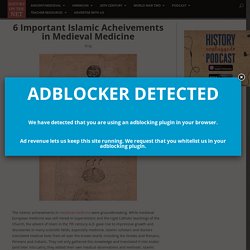
While medieval European medicine was still mired in superstitions and the rigid Catholic teachings of the Church, the advent of Islam in the 7th century A.D. gave rise to impressive growth and discoveries in many scientific fields, especially medicine. Islamic scholars and doctors translated medical texts from all over the known world, including the Greeks and Romans, Persians and Indians. They not only gathered this knowledge and translated it into Arabic (and later into Latin), they added their own medical observations and methods. Islamic doctors developed new techniques in medicine, dissection, surgery and pharmacology. They founded the first hospitals, introduced physician training and wrote encyclopaedias of medical knowledge. Islamic Achievements in Medieval Medicine: Translations Islamic Achievements in Medieval Medicine: Hospitals and Doctor Training.
Arab Influence. It really isn't possible to speak about Spanish food or the Mediterranean diet without noting the importance of the rich legacy of Al-Andalus gastronomy.
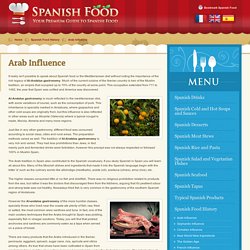
Much of the current cuisine of the Iberian country is heir of the Muslim tradition, an empire that occupied up to 70% of the country at some point. This occupation extended from 711 to 1492, the year that Spain was unified and America was discovered. Al-Andalus gastronomy is much reflected in the mediterranean diet, with some variations of course, such as the consumption of pork. This inheritance is specially marked in Andalusia, where gazpachos and other cold soups are originally from, but this influence is also reflected in other areas such as Alicante (Valencia) where a typical nougat is made, Murcia, Almeria and many more regions.
Just like in any other gastronomy, different food was consumed according to social class, cities and rural areas. How the Moors Influenced Spanish Cuisine. With every bite of their Sunday paella, Spanish families—whether they realize it or not–are paying homage to the old Moorish kingdom of Al-Ándalus, one of the greatest civilizations that Iberia has ever known.
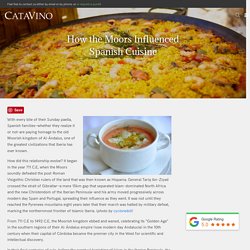
How did this relationship evolve? It began in the year 711 C.E, when the Moors soundly defeated the post-Roman Visigothic Christian rulers of the land that was then known as Hispania. General Tariq ibn-Ziyad crossed the strait of Gibraltar—a mere 15km gap that separated Islam-dominated North Africa and the new Christendom of the Iberian Peninsula—and his army moved progressively across modern day Spain and Portugal, spreading their influence as they went. It was not until they reached the Pyrenees mountains eight years later that their march was halted by military defeat, marking the northernmost frontier of Islamic Iberia. (photo by cyclonebill) Among the Moor’s important gastronomic gifts to Spain, none can have greater significance than rice. Cheers, Sam Zucker. Discovering the Arabic Influence in Spanish Language and Culture.
Arab Influences on Spanish Language and Culture - don Quijote. Star-Finders Astrolabes. Star-Finders Astrolabes Figure 1.

Ahmad ibn Khalaf's Astrolabe, Baghdad (Iraq), 9-10th Century “Astro” means “STAR” in Greek and “+Labe” derives its name from the Greek word “Labio” meaning “Taker” or “FINDER”. The astrolabe accordingly carries a very exciting name, literally meaning… a “STAR-FINDER”.[*] Over a thousand-year period in Muslim Civilisation, epoch-making discoveries and contributions, such as the first record of a star system outside our own galaxy were made. Today the oldest functional astrolabes discovered are mostly from Muslim Civilisation and some of them sold in very high prices in auctions for their elegance and history. Figure 2. Using an Astrolabe. Note of the editor This article has been kindly written for Muslim Heritage by Emily Winterburn in 2005.

Muslim Contribution to Spanish Agriculture. As early as the ninth century, a modern agricultural system became central to economic life and organisation in the Muslim lands.
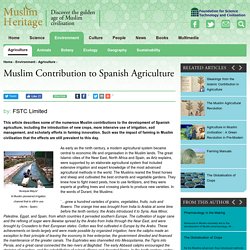
The great Islamic cities of the Near East, North Africa and Spain, as Artz explains, were supported by an elaborate agricultural system that included extensive irrigation and expert knowledge of the most advanced agricultural methods in the world. The Muslims reared the finest horses and sheep and cultivated the best orchards and vegetable gardens. They knew how to fight insect pests, how to use fertilizers, and they were experts at grafting trees and crossing plants to produce new varieties. The Beginning of the Paper Industry. Paper, originally, was brought by the Muslims from China.
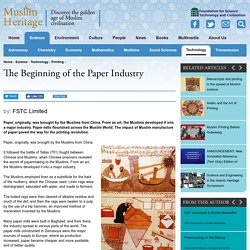
It followed the battle of Tallas (751) fought between Chinese and Muslims, when Chinese prisoners revealed the secret of papermaking to the Muslims. From an art, the Muslims developed it into a major industry. The Muslims employed linen as a substitute for the bark of the mulberry, which the Chinese used. Linen rags were disintegrated, saturated with water, and made to ferment. Costumbres Españolas - Tradiciones en España. Spain - Islamic Arts and Architecture. The Alhambra Considered as one of the most famous examples of Islamic art, the Alhambra is the culmination and grand finale of medieval Islamic culture on the Iberian Peninsula.
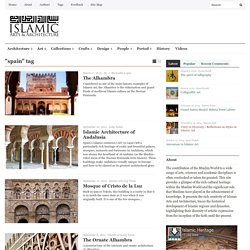
Islamic Architecture of Andalusia Spain’s Islamic centuries (AD 711-1492) left a particularly rich heritage of exotic and beautiful palaces, mosques, minarets and fortresses in Andalusia, which was always the heartland of Al-Andalus (as the Muslim- ruled areas of the Iberian Peninsula were known). These buildings make Andalusia visually unique in Europe and have to be classed as its greatest architectural glory. Mosque of Cristo de la Luz Built in 999 in Toledo, this building is a rarity in that it is in much the same state as it was when it was originally built. Al-Zahrawi – The Pioneer of Modern Surgery – Lost Islamic History. It has often been stated on this website that the Muslim period of Spain’s history (also known as al-Andalus) was a Golden Age of Islamic civilization and society.
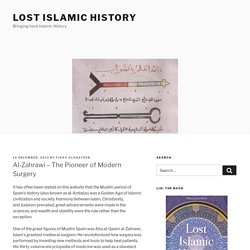
Harmony between Islam, Christianity, and Judaism prevailed, great advancements were made in the sciences, and wealth and stability were the rule rather than the exception. One of the great figures of Muslim Spain was Abu al-Qasim al-Zahrawi, Islam’s greatest medieval surgeon. He revolutionized how surgery was performed by inventing new methods and tools to help heal patients. His thirty-volume encyclopedia of medicine was used as a standard text for medicine throughout Europe for centuries.
The impact he had on how medicine was practiced was truly revolutionary. The Cultural Icon of al-Andalus – Lost Islamic History. Culture is often a difficult topic to study historically.
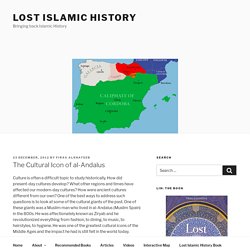
How did present-day cultures develop? What other regions and times have affected our modern-day cultures? How were ancient cultures different from our own? Muslim influence in Spain still felt in daily life - ii, The Milli Gazette, Vol. 2 No. 21. Besides the food crops, the Muslim brought to the Iberian Peninsula the cotton plant, which in Spanish is called algodon from the Arabic alqutn. They also developed the silk industry, to make Al-Andalus one of the major silk manufacturing countries of the medieval world. The fine fabrics of which Europe was to be proud in later centuries had their origin in this land of the Moors. The wealth generated by agriculture would have been insignificant were it not for the excellent irrigation system the Muslim constructed throughout Al-Andalus.
When these former sons of the desert first came to the peninsula, they found a primitive form of a Roman irrigation network. After making a scientific study of the land, they improved this network greatly, completing many hydraulic projects for irrigating their whole domain. Moros y Cristianos - VisitElche. The festivities known as Fiesta de Moros y Cristianos came into being as a commemoration of the period of Islamic domination of most of the Iberian Peninsula and the series of battles that took place between Muslims and Christians. The festival takes place from August 7 through to August 11 and is the first event that honours Nuestra Señora de la Asunción (Our Lady of the Assumption), patron saint of the city. The event which attracts big crowds commemorates the Christian re-conquest of the city and is made of 12 large teams known as comparsas.
Six belong to the Moro (Moorish) side while the other six represent the Christian battalions. Open to both men and women, each comparsa has several hundred members. Religions - Islam: Muslim Spain (711-1492) What did the Moors do for us? a history of the Moors in Spain. One of the curiosities of Spain is the seeming denial by the Spanish of the past existence of the Moors in Spain. Certainly, much is made of the ‘heroic’ Christian Reconquista, but rarely is the Moorish invasion of Spain looked upon as having provided any intrinsic benefit.
In fact, apart from a few scintillating buildings, such as the Alhambra and the Cordoba Mezquita, it would be easy to imagine that, during their 780 years presence, the Moors contributed nothing of consequence to Spain.